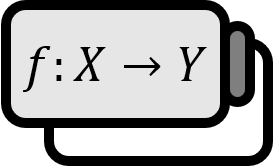Differentiation of Trigonometric Functions
Formula1
The derivatives of trigonometric functions are as follows.
$$ \begin{align*} \dfrac{d}{dx} \sin x &= \cos x \qquad & \dfrac{d}{dx} \csc x &= -\csc x \cot x \\[1em] \dfrac{d}{dx} \cos x &= - \sin x \qquad & \dfrac{d}{dx} \sec x &= \sec x \tan x \\[1em] \dfrac{d}{dx} \tan x &= \sec^{2} x \qquad & \dfrac{d}{dx} \cot x &= -\csc^{2} x \end{align*} $$
Proof
Sum formulas for trigonometric functions $$ \sin\left( \alpha \pm \beta \right) =\sin\alpha \cos\beta \pm\cos\alpha \sin\beta \\ \cos\left( \alpha \mp \beta \right) =\cos\alpha \cos\beta \pm \sin\alpha \sin\beta $$ Limit of the sine function
$$ \lim \limits_{x \to 0} \dfrac{\sin x}{x} = 1 $$
Limit of the cosine function $$ \lim \limits_{x \to 0} \dfrac{1 - \cos x}{x} = 0 $$
$(\sin x)^{\prime} = \cos x$
By the definition of derivatives,
$$ \begin{align*} & \lim\limits_{h \to 0} \dfrac{\sin (x + h) - \sin x}{h} \\ &= \lim\limits_{h \to 0} \dfrac{\sin x \cos h + \sin h \cos x - \sin x}{h} &\small (\because \text{삼각함수의 덧셈공식}) \\ &= \sin x \lim\limits_{h \to 0} \dfrac{\cos h - 1}{h} + \cos x \lim\limits_{h \to 0} \dfrac{\sin h}{h} \\ &= \sin x \cdot 0 + \cos x \cdot 1 \\ &= \cos x \end{align*} $$
■
$(\cos x)^{\prime} = -\sin x$
By the definition,
$$ \begin{align*} & \lim\limits_{h \to 0} \dfrac{\cos (x + h) - \cos x}{h} \\ &= \lim\limits_{h \to 0} \dfrac{\cos x \cos h - \sin h \sin x - \cos x}{h} &\small (\because \text{삼각함수의 덧셈공식}) \\ &= \cos x \lim\limits_{h \to 0} \dfrac{\cos h - 1}{h} - \sin x \lim\limits_{h \to 0} \dfrac{\sin h}{h} \\ &= \cos x \cdot 0 - \sin x \cdot 1 \\ &= - \sin x \end{align*} $$
■
$(\tan x)^{\prime} = \sec^{2} x$
$$ \left( \frac{f}{g} \right)^{\prime}(x) = \frac{f^{\prime}(x)g(x)-f(x)g^{\prime}(x)}{g^{2}(x)} $$
By the quotient rule,
$$ \begin{align*} & \tan^{\prime}x \\ &= \left( \dfrac{\sin x}{\cos x} \right)^{\prime} \\ &= \dfrac{\sin^{\prime} x \cos x - \sin x \cos^{\prime} x}{\cos^{2} x} \\ &= \dfrac{\cos x \cos x + \sin x \sin x}{\cos^{2} x} \\ &= \dfrac{1}{\cos^{2} x} \\ &= \left( \dfrac{1}{\cos x} \right)^{2} \\ &= \sec^{2}{x} \end{align*} $$
■
$(\csc x)^{\prime} = -\csc x \cot x$
By the chain rule,
$$ \begin{align*} \dfrac{d}{dx} \csc x &= \dfrac{d}{dx} \left( \dfrac{1}{\sin x} \right) \\ &= \dfrac{d}{d(\sin x)} \left( \dfrac{1}{\sin x} \right) \dfrac{d(\sin x)}{dx} \\ &= -\dfrac{1}{\sin^{2} x} \cos x \\ &= -\dfrac{1}{\sin x}\dfrac{\cos x}{\sin x} \\ &= -\csc x \cot x \end{align*} $$
■
$(\sec x)^{\prime} = \sec x \tan x$
By the chain rule,
$$ \begin{align*} \dfrac{d}{dx} \sec x &= \dfrac{d}{dx} \left( \dfrac{1}{\cos x} \right) \\ &= \dfrac{d}{d(\cos x)} \left( \dfrac{1}{\cos x} \right) \dfrac{d(\cos x)}{dx} \\ &= -\dfrac{1}{\cos^{2} x} (- \sin x) \\ &= \dfrac{1}{\cos x}\dfrac{\sin x}{\cos x} \\ &= \sec x \tan x \end{align*} $$
■
$(\cot x)^{\prime} = -\csc^{2} x$
$$ \begin{align*} (\cot x)^{\prime} &= \left( \dfrac{\cos x}{\sin x} \right)^{\prime} \\ &= \dfrac{(\cos x)^{\prime} \sin x - \cos x (\sin x)^{\prime}}{\sin^{2} x} \\ &= \dfrac{-\sin^{2} x - \cos^{2} x}{\sin^{2} x} \\ &= -\dfrac{1}{\sin^{2} x} \\ &= -\csc^{2} x \end{align*} $$
James Stewart, Daniel Clegg, and Saleem Watson, Calculus (early transcendentals, 9E), p191-197 ↩︎
